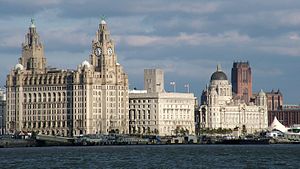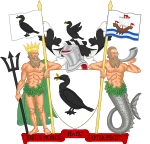Liverpool
Liverpool is a city in North West England, United Kingdom with a population of about 485,000 in 2015.[2] It is part of the Liverpool-Birkenhead metropolitan area, the fifth-largest metropolitan area in the UK. The local government is Liverpool City Council.
Liverpool | |
|---|---|
 The three graces of Liverpool's waterfront: the Royal Liver Building, the Cunard Building and the Port of Liverpool Building. Visible in the background is Liverpool's Anglican Cathedral. | |
 Coat of arms of Liverpool City Council | |
| Nickname: The Pool | |
 Location within England | |
| Coordinates: 53°24′N 2°59′W / 53.400°N 2.983°W | |
| Sovereign state | United Kingdom |
| Constituent country | England |
| Region | North West England |
| Ceremonial county | Merseyside |
| Admin HQ | Liverpool City Centre |
| Founded | 1207 |
| City Status | 1880 |
| Government | |
| • Type | Metropolitan borough, City |
| • Governing body | Liverpool City Council |
| Area | |
| • Metropolitan borough & City | 43.18 sq mi (111.84 km2) |
| Elevation | 230 ft (70 m) |
| Population (2007 est / Urban=2006) | |
| • Metropolitan borough & City | 447,500 (Ranked 5th) |
| • Density | 12,950/sq mi (5,001/km2) |
| • Urban | 816,900 |
| • Metro | 1,103,089 |
| • Ethnicity (2005 Estimate)[1] | 91.9% White 2.2% Chinese and other 2.1% Asian or Asian British 1.9% Mixed Race 1.9% Black or Black British |
| Time zone | UTC+0 (Greenwich Mean Time) |
| • Summer (DST) | UTC+1 (British Summer Time) |
| Postal Code | |
| Area code | 0151 |
| ISO 3166-2 | GB-LIV |
| ONS code | 00BY |
| OS grid reference | SJ437905 |
| NUTS 3 | UKD52 |
| Demonym | Scouser/Liverpudlian |
| Website | www.liverpool.gov.uk |
Liverpool is on the eastern side of the River Mersey. It used to lie in the old area of West Derby in the south west of Lancashire. It became a borough in 1207 and a city in 1880. In 1889, it became separate from Lancashire. Liverpool's growth as a large port was matched by the growth of the city during the Industrial Revolution.
It was most famous as a port during the late 19th and early 20th century. It is the birthplace of the famous rock group The Beatles. It is also famous because of its football teams, Everton F.C. and Liverpool F.C.
People from Liverpool are called Liverpudlians or Scousers. People from Birkenhead are called "Plastic Scousers" by some.
History
changeLiverpool became very important due to trade in sugar, tobacco and especially slaves.[3] In 1818, the Black Ball Line, with a fleet of sailing ships, offered the first regular passenger service with emphasis on passenger comfort, from England to the United States.
In the 19th Century, transatlantic trade and passenger travel was served to destinations such as New York City from Liverpool by:
- Black Ball Line (trans-Atlantic packet) (1817–1877)
- Cunard Line (1840–)
- White Star Line (1845–1934)
- Collins Line (1818–1858)
- Leyland Line (1873–1901)
- Guion Line (1866–1894)
- Inman Line (1850–1893)
In 1830, Liverpool and Manchester became the first cities to have a railway connecting them to each other, the Liverpool and Manchester Railway. Not including airports in London, Liverpool Airport was the first airport in Britain opening in 1930. In 2008 it was awarded the title European Capital of Culture.
Geography
changeLiverpool is a city on the River Mersey, on the coast next to the Irish Sea. On the other side of the river Mersey is the Wirral. In 1846 the Albert Dock was opened and in 1988, turned into a shopping centre.
Culture
changeThe city is the birthplace of the famous rock group The Beatles and the musical style Merseybeat. It has several art galleries, museums and theatres. The Tate Liverpool is a gallery of modern art, the Walker Art Gallery displays classical art, the Bluecoat and FACT exhibit contemporary art. Museums include the World Museum, the Maritime Museum and the Museum of Liverpool. There are two cathedrals, Liverpool Cathedral which is known as Anglican and Metropolitan Cathedral which is Catholic. There are two famous football clubs, Liverpool F.C. and Everton F.C. It has several parks including Sefton Park and Stanley Park.
Transport
changeLiverpool Airport opened in 1930, it was later renamed Liverpool John Lennon Airport. It has three tunnels under the River Mersey, one for trains and two (Queensway and Kingsway) for cars travelling to and from Wirral.
Rail
changeIt has a local train network called Merseyrail and the station Liverpool Lime Street provides train travel to and from the rest of the United Kingdom. Until the 1950s it also had Liverpool Overhead Railway and Liverpool Corporation Tramways. Liverpool is connected to the West Coast Main Line railway connecting London, Birmingham, Manchester, Edinburgh and Glasgow.
Road
changeMotorways running into Liverpool include the M62 from Manchester, the M58 and the M53 from Wirral. The inner ring road is Queens Drive and the outer ring road is the M57.
Sea and river
changeLiverpool Cruise Terminal opened in 2007 and provides travel to Europe. Regular ferries services operate to Wirral and the Isle of Man. River cruises operate down the Manchester Ship Canal and the Leeds Liverpool Canal also connects into Liverpool.
Education
changeLiverpool has several universities;
- University of Liverpool,
- Liverpool John Moores University,
- Liverpool Hope University
- Liverpool Institute of Performing Arts.
Famous places
change- Albert Dock
- St George's Hall
- Liverpool Cathedral
- Speke Hall
- Merseyside Maritime Museum
- International Slavery Museum
- Tate Liverpool
- The Beatles Story
- Pier Head
- Al-Rahma Mosque
- Goodison Park
- Anfield
Famous people from Liverpool
change- The Beatles (John Lennon, Paul McCartney, George Harrison, and Ringo Starr).
- Steven Gerrard, Rangers F.C. Manager, Former Liverpool F.C. & England National Team captain
- Jamie Carragher, Liverpool Football Club Legend
- Tom Baker, actor (Doctor Who)
- Ken Dodd, comedian
- Echo and the Bunnymen
- Julian Lennon, musician, son of John Lennon and his first wife, Cynthia.
- Brian Epstein, music mogul
- Frankie Goes to Hollywood, music group
- Gerry Marsden, musician
- Gerry and the Pacemakers, music group
- Cilla Black, entertainer
- Paul O'Grady, former drag act and television presenter
- David Morrissey, actor
- Jason Isaacs, actor
- Miles Kane, musician
- Melanie C, Sporty Spice, member of the Spice Girls
- John Bishop, comedian and actor
- Clive Barker, author & director
- Peter Serafinowicz, actor & comedian
- Kim Cattrall, actress
- Jodie Comer, actress
- Freddie Starr, Comedian, actor & musician
Development
changeThere has been a lot of development work which is part of a regeneration plan for Liverpool. It is because Liverpool was the Capital of Culture for 2008.
References
change- ↑ "Neighbourhood Statistics: Resident Population Estimates by Ethnic Group (Percentages)". Office for National Statistics. Retrieved 2011-05-20.[permanent dead link]
- ↑ "Population Estimates for UK, England and Wales, Scotland and Northern Ireland - Office for National Statistics". www.ons.gov.uk. Retrieved 2017-09-11.
- ↑ Tibbles, Anthony (2000). "Ports of the Transatlantic slave trade". National Museums Liverpool. Retrieved 2020-11-08.
In reality, though, the half dozen or so ships that somewhere like Chester or Poulton sent is insignificant compared with the dominant involvement of Liverpool (5300 voyages), London (3100 voyages) and Bristol (2200 voyages) which between them accounted for over 90% of the British trade. And the process of domination seems to have accelerated at the end of the century with Liverpool not only outstripping its English rivals but the European competition. In the two decades preceding abolition, Liverpool was responsible for 75% of all slaving voyages across Europe.